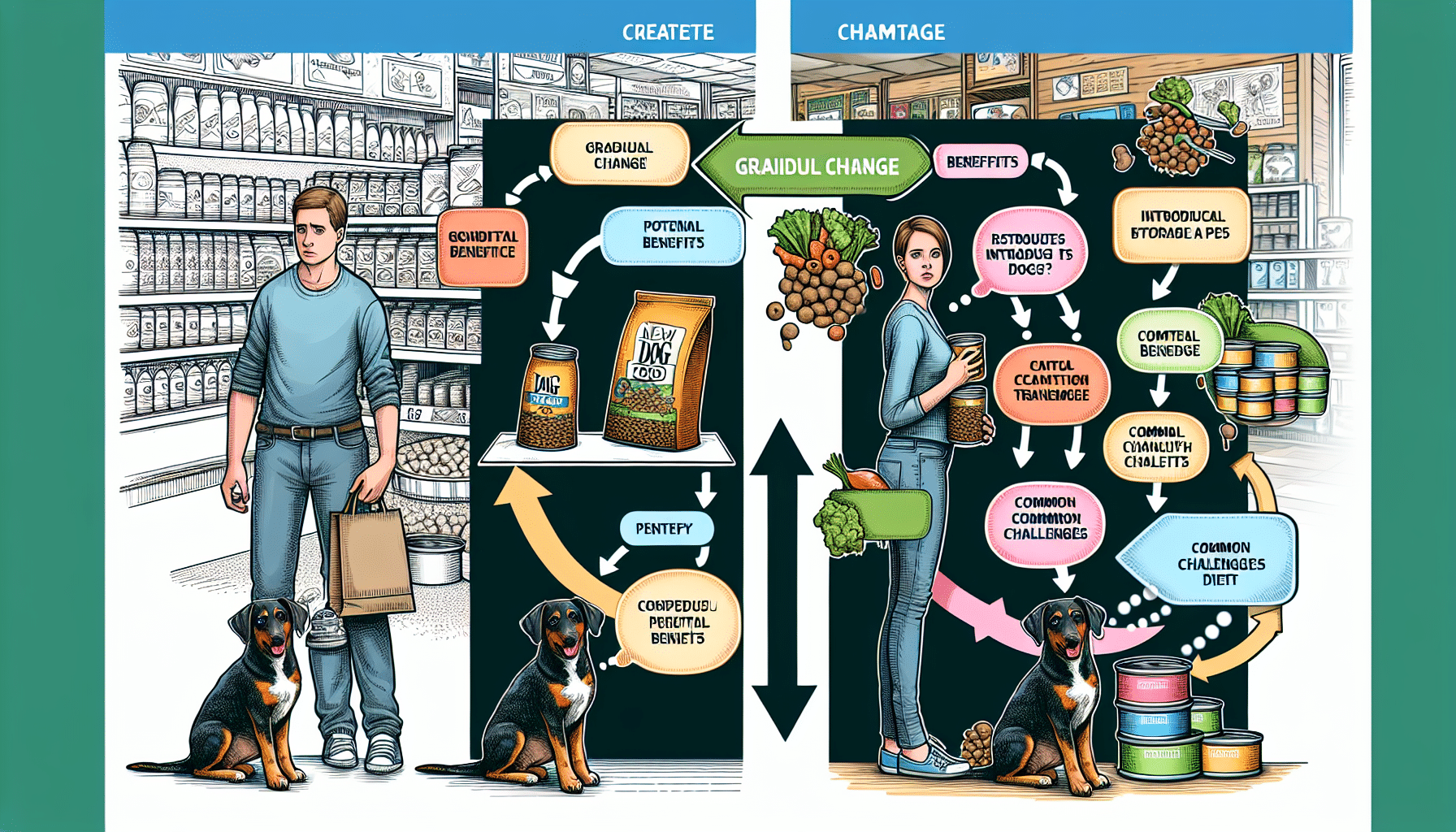Are you considering switching your dog to a new food? Transitioning your furry friend to a new diet can be a delicate process, but with a few helpful tips, it can be a smooth and successful journey. In this article, we will explore some key strategies on how to transition your dog to a new food, ensuring that they adjust comfortably and happily to their new diet. Whether you're changing their food due to dietary restrictions or simply to explore different options, these tips will guide you through the process, making it a positive and stress-free experience for both you and your furry companion.
Why Transitioning Your Dog to a New Food is Important

This image is property of images.unsplash.com.
Understanding the Importance of a Gradual Transition
Transitioning your dog to a new food is important because it helps to ensure a smooth and successful switch without causing any digestive upsets or refusal to eat. Dogs can be sensitive to sudden changes in their diet, and a gradual transition allows their digestive system to adjust gradually to the new food. By slowly introducing the new food while still incorporating the old food, you can help your dog adapt to the change more easily.
Avoiding Digestive Upsets in Your Dog
One of the main reasons for transitioning your dog to a new food gradually is to avoid digestive upsets. Sudden changes in diet can lead to gastrointestinal issues, such as diarrhea, vomiting, or even constipation. These symptoms can be distressing for your furry friend and may require a visit to the veterinarian. By gradually transitioning your dog to the new food, you minimize the risk of digestive upsets and help them maintain a healthy digestive system.
Preventing Refusal to Eat
Sometimes, when you abruptly switch your dog's food, they might refuse to eat it. Dogs can be creatures of habit, and sudden changes can disrupt their routine and appetite. By transitioning your dog to a new food gradually, you can prevent refusal to eat. By mixing a small percentage of the new food with their old food and slowly increasing the ratio over time, you help your dog become accustomed to the taste and texture of the new food, increasing their likelihood of accepting it without hesitation.
Choosing the Right Time to Transition
When to Start Transitioning
The right time to start transitioning your dog to a new food depends on their current health condition and any dietary restrictions they may have. In general, it is recommended to start the transition over the course of about one to two weeks. However, if your dog has any underlying health issues or is currently on medication, it's important to consult with your veterinarian to determine the best time to start the transition. They can provide guidance on when to begin based on your dog's individual needs.

This image is property of images.unsplash.com.
Considering Your Dog's Health Condition
Before transitioning your dog to a new food, it's essential to consider their current health condition. If your dog has any specific health issues, such as allergies, digestive sensitivities, or dietary restrictions, it may require a more specialized approach to the transition. In such cases, consulting with your veterinarian is crucial, as they can recommend appropriate dietary alternatives or prescribe specific diets to address your dog's health condition while transitioning to a new food.
Understanding Your Dog's Dietary Needs
Consulting a Veterinarian
Consulting a veterinarian is an important step in understanding your dog's dietary needs. They can provide valuable information and guidance on the best type of food for your dog based on their age, breed, and any specific health concerns. Veterinarians are well-versed in canine nutrition and can offer expert advice tailored to your dog's individual needs, ensuring they receive a well-balanced and nutritious diet.
Identifying Food Allergies or Sensitivities
During the transition process, it's crucial to identify any potential food allergies or sensitivities your dog may have. If your dog experiences significant digestive upsets or allergic reactions, such as excessive itching, ear infections, or gastrointestinal distress, it may indicate an adverse reaction to certain ingredients in their food. Keeping a close eye on your dog's reactions during the transition can help pinpoint any allergens or sensitivities, allowing you to select a new food that avoids those ingredients.
Determining the Right Nutritional Balance
Each dog has unique nutritional needs, and it's essential to ensure they receive the right balance of nutrients. Dogs require a mix of proteins, carbohydrates, fats, vitamins, and minerals for optimal health. When transitioning to a new food, consider the nutritional profile of both the old and new food, ensuring the new food aligns with your dog's requirements. Your veterinarian can provide guidance on the appropriate nutritional balance based on factors such as your dog's age, activity level, and any specific health conditions.
Selecting the New Dog Food

This image is property of images.unsplash.com.
Considering Your Dog's Age and Breed
When selecting a new dog food, it's important to consider your dog's age and breed. Puppies have different nutritional requirements than adult dogs, as do senior dogs. Additionally, certain breeds may have specific dietary needs or be predisposed to certain health conditions. By selecting a food that is tailored to your dog's age and breed, you can ensure they receive the appropriate nutrients to support their growth, development, and overall health.
Researching Nutritional Values
Before making a decision on a new dog food, take the time to research and compare the nutritional values of different brands and formulations. Look for foods that meet the standards set by reputable organizations, such as the Association of American Feed Control Officials (AAFCO). The AAFCO sets guidelines for the nutritional adequacy of pet foods, ensuring they provide the necessary nutrients for dogs of different life stages. By researching and comparing nutritional values, you can identify a high-quality food that meets your dog's specific nutritional needs.
Reading Ingredient Lists
Another important aspect of selecting a new dog food is to carefully read and understand the ingredient lists. Look for products that list high-quality protein sources, such as chicken, beef, or fish, as the first ingredient. Avoid foods that contain a high amount of fillers, artificial preservatives, or additives. Ingredients like whole grains, fruits, and vegetables are beneficial additions, as they provide essential vitamins, minerals, and fiber. By focusing on high-quality ingredients, you can ensure your dog receives a nutritionally balanced and wholesome diet.
Tools and Techniques for a Successful Transition
Use of Mixing Bowls and Spoons
To facilitate a smooth transition, it's helpful to have the right tools on hand. Mixing bowls and spoons can make the process easier. Start by mixing a small percentage of the new food with your dog's old food in a mixing bowl. Use a spoon to thoroughly combine the two foods, ensuring an even distribution. These tools allow you to control the blending process, gradually increasing the proportion of the new food over time.

Understanding the 10-10-10 Rule
The 10-10-10 rule is a guideline that can help ensure a successful transition. It involves gradually increasing the percentage of the new food over a period of ten days. In the first three days, mix 10% of the new food with 90% of the old food. Over the next three days, adjust the ratio to 30% new food and 70% old food. In the following three days, increase the ratio to 50% new food and 50% old food. Finally, in the last day, feed your dog 90% new food and only 10% of the old food. This gradual approach allows your dog to adjust to the new food without overwhelming their digestive system.
Trying Topping Techniques
If your dog is hesitant to eat the new food, you can try using topping techniques to entice them. Adding a small amount of a tasty food to the new food can make it more appealing. For example, you can mix in a spoonful of wet dog food, low-sodium broth, or a sprinkling of grated cheese. These toppings can add flavor and aroma to the new food, making it more enticing for your dog. Gradually reduce the use of toppings as your dog becomes more comfortable with the new food.
Gradually Introducing the New Food
Creating a Transition Schedule
Having a transition schedule can help you stay organized and ensure a smooth transition for your dog. Plan out the proportions of the new and old food for each day, following the 10-10-10 rule, if applicable. Write down the schedule and stick it on your fridge or keep it in a visible place to help you remember the proportions and dates. By having a clear plan, you can avoid confusion and provide consistency during the transition process.
Starting with a Small Percentage of New Food
When introducing the new food, start with a small percentage and gradually increase it with each meal. This allows your dog's digestive system to adjust to the new ingredients slowly. Begin with a ratio of 10% new food and 90% old food and keep this proportion for the first few days. As your dog tolerates the new food well, gradually increase the percentage by increments of 10% every few days until you reach the desired ratio.

Monitoring Your Dog's Reaction
Throughout the transition process, it's crucial to closely monitor your dog's reaction to the new food. Watch for any signs of discomfort, digestive upsets, or changes in appetite. Monitor their energy levels, coat condition, and overall well-being. Pay attention to any allergic reactions, such as itching, redness, or gastrointestinal distress. By observing your dog's response, you can identify any issues early on and make necessary adjustments to ensure a successful transition.
Observing Your Dog's Response
Checking for Allergic Reactions or Digestive Issues
During the transition process, it's important to keep an eye out for any allergic reactions or digestive issues your dog may experience. Symptoms of an allergic reaction can include excessive itching, redness, swelling, or gastrointestinal distress. If you notice any of these signs, discontinue the new food and consult with your veterinarian. Similarly, monitor your dog for any digestive issues, such as diarrhea, vomiting, or constipation. These symptoms may indicate that the transition is too abrupt or that the new food is not suitable for your dog.
Looking for Signs of Discomfort or Appetite Change
Changes in your dog's behavior or appetite can be indicators of discomfort during the transition process. Pay attention to any signs of lethargy, reluctance to eat, or unusual behavior. If your dog shows signs of distress or a sudden loss of appetite, it may indicate that the new food is not agreeing with them. In such cases, consider adjusting the transition schedule or consulting with your veterinarian for further guidance.
Monitoring Bowel Movements
Another aspect to observe during the transition is your dog's bowel movements. Sudden changes in diet can sometimes lead to changes in stool consistency or frequency. Monitor your dog's bowel movements for any signs of diarrhea, constipation, or abnormal stool. Temporary changes in bowel movements can be expected during the transition, but if they persist or become severe, it's important to consult with your veterinarian to ensure your dog's health and well-being.
Making Adjustments and Continuing the Transition
Adjusting the Transition Schedule if Needed
If you notice any adverse reactions or discomfort during the transition, it may be necessary to adjust the transition schedule. Slow down the rate at which you are increasing the percentage of the new food or even pause the transition for a few days to allow your dog's digestive system to adjust. It's essential to prioritize your dog's well-being and make adjustments as needed to ensure a successful and comfortable transition.
Increasing the Percentage of New Food Gradually
As your dog continues to tolerate the new food without any adverse reactions, gradually increase the percentage of the new food. Stick to the 10-10-10 rule or adjust the ratio based on your dog's individual needs and response. Keep in mind that some dogs may need a longer transition period than others. Take it at your dog's pace and increase the new food percentage gradually until you are feeding them solely with the new food.
Seeking Veterinary Advice if Problems Arise
If you encounter any significant issues or concerns during the transition, it's important to seek veterinary advice promptly. Your veterinarian can provide tailored guidance and recommendations based on your dog's specific needs and condition. They may suggest alternative food options or even perform tests to identify any underlying health issues or allergies. Open communication with your veterinarian plays a crucial role in ensuring a successful transition and maintaining your dog's overall health.
Transitioning to a New Food With Special Dietary Needs
Considering Prescription Diets
For dogs with special dietary needs or health conditions, transitioning to a new food may require the use of prescription diets. Prescription diets are specially formulated to address specific health concerns and are typically recommended by veterinarians. These diets may be necessary for dogs with allergies, gastrointestinal issues, kidney disease, or weight management needs. If your dog falls into this category, consult with your veterinarian to select the appropriate prescription diet and to discuss the transition process.
Addressing Weight Management Issues
If your dog is overweight or has weight management issues, transitioning to a new food can be an opportunity to address those concerns. Look for foods specifically designed for weight management or consult with your veterinarian to determine the appropriate caloric intake for your dog. During the transition, consider the long-term goal of achieving a healthy weight for your dog and adjust the portions accordingly. Regular monitoring of their weight and body condition throughout the transition process will help guide the feeding amounts and ensure a successful weight management plan.
Accommodating Senior Dogs' Dietary Requirements
Senior dogs have unique dietary requirements due to changes in their metabolism and potential age-related health conditions. When transitioning a senior dog to a new food, consider their specific needs, such as joint health support, dental care, or reduced caloric intake. Look for senior-specific formulas that address these needs and consult with your veterinarian to create a transition plan that supports your senior dog's long-term health.
Maintaining a Healthy Transition
Ensuring a Balanced Diet
Throughout the transition process and beyond, it's crucial to ensure your dog receives a balanced and nutritious diet. Once your dog has successfully transitioned to the new food, continue to monitor their overall health and well-being. Regularly assess the quality of the food you are feeding and look for any signs of nutrient deficiencies or excesses. If you have any concerns about your dog's diet, consult with your veterinarian to ensure they are receiving the necessary nutrients for optimal health.
Monitoring Your Dog's Long-term Health
Transitioning to a new food is just one part of maintaining your dog's long-term health. It's important to continue monitoring their overall well-being, including their energy levels, coat condition, and weight. Regular veterinary check-ups and discussions with your veterinarian about your dog's diet are essential to address any evolving health needs or concerns. By staying proactive and attentive to their long-term health, you can make informed decisions regarding their diet and ensure their continued well-being.
Avoiding Frequent Food Changes
Once you have successfully transitioned your dog to a new food, it's generally best to avoid frequent food changes. Dogs thrive on consistency, and constant fluctuations in their diet can lead to digestive upsets and difficulty in maintaining a healthy weight. If you do need to switch your dog's food in the future, follow the same gradual transition process outlined in this article. By adhering to a consistent routine and making changes thoughtfully, you can help your dog maintain a stable and healthy diet.
In conclusion, transitioning your dog to a new food requires careful planning, patience, and attention to your dog's unique needs. By understanding the importance of a gradual transition, considering your dog's health condition and dietary needs, selecting the right food, utilizing appropriate tools and techniques, and closely observing your dog's response, you can ensure a successful and healthy transition. Remember to consult with your veterinarian throughout the process to receive professional guidance and support. With proper care and attention, you can help your furry friend adapt to their new food, ensuring their long-term health and happiness.


